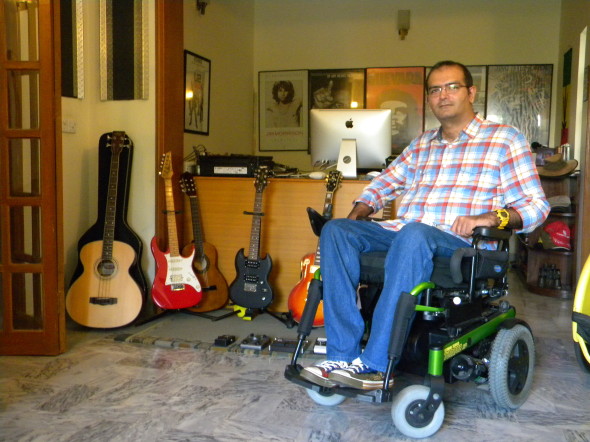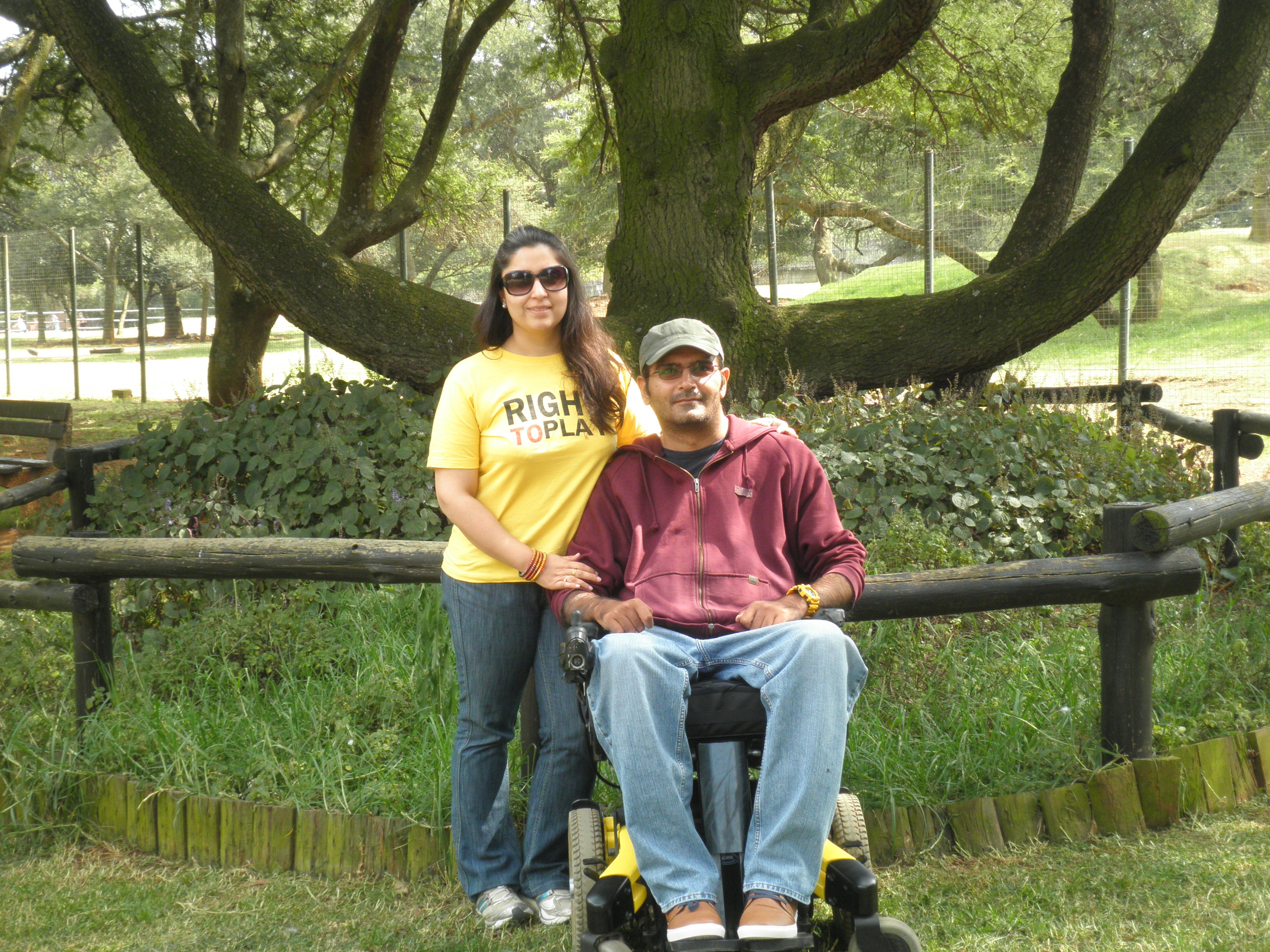‘If you’re expecting a tearjerker… then I’ve got news for you. Go read Mills & Boons and all such heart breaks because this young man, I assure you, is anything but poor…So now that we have the basics out of the way let me walk – sorry! Let me roll you through my life.’(Sarmad Tariq, on sarmadtariq.com)
When Sarmad Tariq dived into a stream while on holiday in Gujranwala with his cousins, he was unaware that the water was a scarce two and half feet deep. A skilled swimmer at the age of fifteen, he looked forward to taking part in the junior national swimming competition trials two months away. The accident that left him paralysed from the shoulders down after breaking his neck in three places put paid to that ambition. The following months saw doctors and family despair at his condition, – added to everything else, bedsores caused a dislocation of his hip and major poisoning in his body -until his parents sold their limited assets and took him to England for treatment. During his brief ten weeks at Stoke Mandeville Hospital, known for its specialisation in spinal injuries, Tariq improved and eventually learned how to sit and dress himself. When the money ran out, and it was clear that he would have to return to Pakistan, the staff gave him verbal guidance and he taught himself. They gave him a strap to wind around his fingers and help him to hold his toothbrush. They gave him a leg bag in place of an ordinary catheter and hospital urine bag, which causes severe infections in many handicapped Pakistanis. And he got his first custom made wheelchair, with a silicone gel cushion to aid circulation and to prevent bedsores. He noticed that his fingers refused to bend if they remained outstretched, so he bandaged his fists together at night and developed muscle control so that he could hold small, delicate objects, and eventually learned to type using his knuckles. All this came many years before treatment with an occupational therapist in South Africa early in 2012. With her, while learning other co ordination techniques, he embarked on a new chapter: designing a pick and slide that would help him to play the electric guitar.
What could easily have been Tariq’s nemesis awakened his sense of challenge. It is this spirit which continues to motivate him as he goes through life.
Today, Tariq sports a tiny ‘Allah’ tattoo on his neck at the point where it was broken, close to the jugular vein. Telling the stories behind key events in his life has become something that he consciously practises, partly because it has become his livelihood as a motivational speaker; this is one of them. The stories are interwoven with the spirit of defiance, which comes out in the blog that he writes: short conversations with his imaginary friend Shuntoo, in which he frequently challenges social attitudes – not regarding the handicapped but to life in general.
Returning from England, Tariq was determined to go back to mainstream education to ensure that he could become financially independent. Against advice from college staff, friends and even sometimes well wishing family members, he rushed to make up for lost time. After sitting for his intermediate examination privately he became a regular student at Sir Syed College in Rawalpindi, and later finished with a major in business from a private university. It was in the early 2000s, after resigning from his job in human resources at a petroleum technology company, that he met Kamran Rizvi of Navitus and began work as a motivational speaker at leadership training sessions, corporate events and for NGOs specialising in disability. For which, he says smilingly, he is very well paid. It is this success which gives him freedom and enables him to speak for free at youth conferences at local schools and colleges.
Occupying a wheelchair did not destroy his sportsman’s spirit. His thirst for sport re-awakened when he became financially stable, and in 2004 he began to look for activities that he could take part in. Without a local sports infrastructure, the choices were limited. What he could do well, he concluded, was driving. With sponsorship from Fauji Fertilizer, TCS, and Unilever, he drove non-stop for thirty three hours using an automatic car fitted with a kit attached to the steering column, by which he could operate the brake and accelerator. But when it was over, he felt that the effort was too easy. He needed something more physically and mentally challenging. So he googled sports for quadriplegics and found that the recommended strenuous sport was the wheelchair marathon.
Finding and entering a wheelchair marathon event came with its own set of obstacles. When he wrote to the Association of International Marathons, they replied to let him know that there were qualification requirements, such as the competing athlete’s endurance ability. However, they advised him to look for marathons in the Asian region. The Indian chapter guided him to Standard Chartered Bank, which was due to sponsor a marathon in Lahore. When Tariq contacted the bank, he discovered that a handicapped person had not taken part in a local marathon before. He was considered a safety hazard against the other athletes, none of whom were handicapped. He needed a special wheelchair, in which he would have to crouch with his knees against his chest and propel the wheels with his arms. The bank finally agreed to sponsor him and to fund the cost of the racing wheelchair, which was over five lakhs. When it arrived, just six weeks before the event, Tariq almost had an accident. When he learned how to use it, he practised late every night, riding ten kilometre distances on main roads. On the day of the race, the bank arranged a ‘fun marathon’ of six kilometres for handicapped athletes using ordinary wheelchairs, but Tariq ran the full marathon of forty two kilometers. A continuous crowd collected to wave him on, and over eighty stayed with him until the finish line. By the time he reached it, the organisers and the media had left, and only his family and friends were waiting. But he was given a mention in the Lahore marathon book, with a notice recording the time it took him to complete the distance: seven and a half hours. No mean feat, considering his short training programme, that he has osteo-arthritis, his body has a tendency to ‘lock up’ in muscle spasms, and that his lungs operate at a third of a normal person’s capacity, causing him to cough blood during the race.
The Lahore marathon took place in January 2005, and was followed at the end of that year by the New York marathon, where he was accepted as the only person from Pakistan to take part in it. In the days just before the race he fell and ruptured his hip. Fearing that the doctors would disqualify him if he told them, he treated himself with painkillers and ointments. As he says, ‘I discussed it with my wife, Zehra, and we both decided I had come so far that I should go ahead with it, only going as far as I felt I could. I thought I would be able to manage about five kilometres. The first leg was Staten Island Bridge – it’s a curved bridge so you are going uphill. Then you go down and you need to use brakes. When I finished that I decided to keep going. The eighteenth kilometre is supposed to be crucial because that’s when you are tempted to give up. But the spectators, and the guides assigned to me along the road kept cheering and chanting ‘pain is temporary, pride is forever.’ He finished the race, sixth last among a hundred participants. Coming just short of his thirtieth birthday, the event was all the more significant because it marked the equal number of years that he had spent as a normal, healthy person and as a quadriplegic.
Tariq is currently planning his latest venture which is to drive the Karakoram Highway from Islamabad to Khunjerab, not without its physical risks because one stretch will involve very high altitude driving and the chance of requiring oxygen. It will be sponsored by Mobilink, and the tag line, aptly summarises his own attitude, is ‘Mera Jazba.’ ‘I’m glad that for the first time, Mobilink is investing in motivation – youth ka jazbaa. And I consider myself blessed to be able to indulge my sense of adventure.’ This time round, there will be coverage, during and after the event. A media team will accompany him, and a forty minute documentary will be made. This will be released on DVD and given to colleges and universities, where Tariq will speak at the screenings. To be made by Forward Media, it will document two elements: his daily life, and the challenges he sets for himself.
‘It’s a tricky business,’ says Tariq of his professional work as a motivational speaker. ‘You have to be careful because you don’t want to preach. And it’s easy to get carried away and boast about oneself.’ He considers his wife Zehra, a clinical psychologist and development consultant to whom he has been married for eleven years, as the person who grounds him. What he wants people to understand, through the example of his own experience, is that health is a blessing, not a right, and that if one gets past the idea of complaining, it is possible to achieve things.







